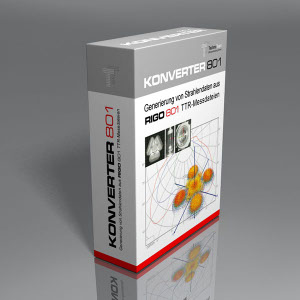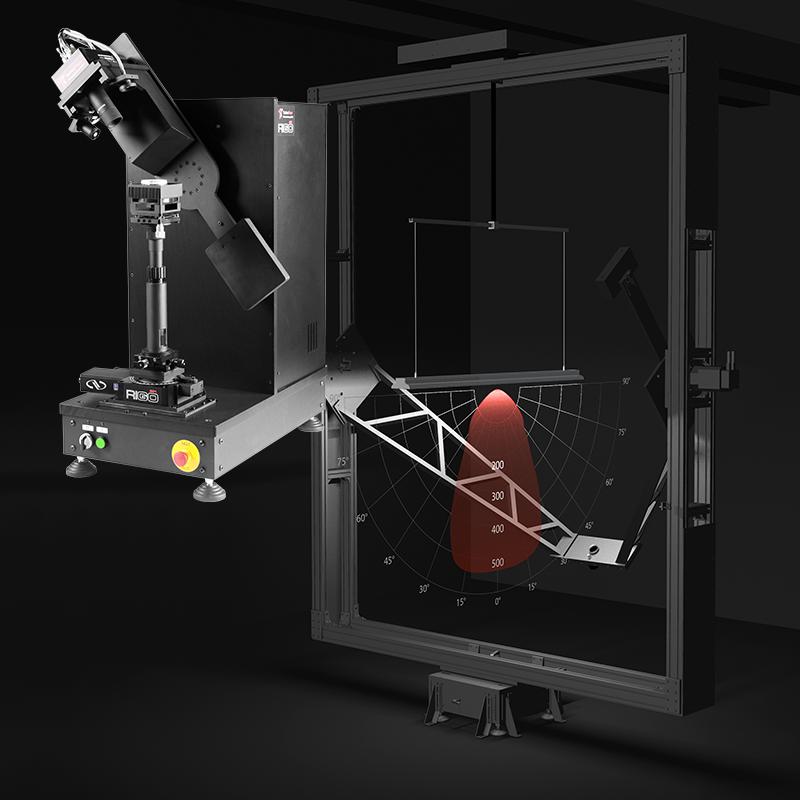Kostenlose Software Konverter801
Das Programm Konverter801 dient zur Verarbeitung der TechnoTeam Strahlendateien (TTR Format).
Funktionen
- Ausgabe verschiedener Dateiformate (TM25, ASAP, Speos, LightTools, LucidShape, Zemax, TracePro, Photopia)
- Generierung spektraler Strahlendaten
- Aufbereitung einer universellen TTR Austauschdatei (Vorgabe von Konvertierungsparametern, Löschen und Bearbeiten interner Informationen, Einbinden von Datenblättern, Reports oder sonstigen Daten)
- Berechnung von Nahfeld - Lichtstärkeverteilungen
- Berechnung des virtuellen Fokuspunktes der Strahlendaten
- API für den Zugriff auf das TechnoTeam Strahlendatenformat

Diese Software ist lizenzkostenfrei und kann ohne Einschränkungen verwendet werden.
RELEVANTE PRODUKTE UND ANWENDUNGEN
Downloads
Publikationen
Spectral ray data for optical simulations
Advanced Optical Technologies
This paper summarizes selected approaches, to generate spectral ray data for different types of spectrally varying light sources including only angular variable as well as spatial and angular variable sources. This includes a description of their general ideas and applications, the required measurements, and their mathematical concepts. Finally, achieved results for an Red/Green/Blue/White-light emitting diode (RGBW-LED) system are shown. Ray tracing simulations of a spatially and angularly spectral varying LED system combined with a spectrally sensitive optical system are qualitatively and quantitatively compared to a colorimetric far-field measurement of the same system. The results demonstrate the potential and benefits of spectral ray files in general.
Bestimmung von winkel- und ortsaufgelösten spektralen Rayfiles
LICHT
Die Anforderungen an Lichtquellenmodelle im Entwurfsprozess moderner Leuchten für die allgemeine Lichttechnik nehmen im Zuge der steigenden Anforderungen an die Beleuchtungstechnik stetig zu. Dabei rückt zunehmend auch die ort- und winkelaufgelöste Farb- und Spektralverteilung in den Vordergrund. Basierend auf der Annahme, dass die spektrale Variation von Lichtquellen als gewichtete Summe von konstanten Basisspektren beschreibbar ist, soll in diesem Beitrag ein allgemeiner Messansatz zur Erzeugung solcher Lichtquellenmodelle vorgestellt werden Der Schwerpunkt liegt dabei auf der Messung und Rekonstruktion der spektralen Information. Des Weiteren wir das Verfahren auf Basis einer leuchtstoffbasierten Weißlicht-LED getestet und mit dem speziell auf diese LED-Familie zugeschnittenen Stand der Technik – dem Blau/Gelb Rayfile – vergleichen.
Measurement of Angular and Spatial Resolved Spectral Rayfiles
LED Professional
The enhanced complexity of modern lighting systems has increased the importance of realistic light source models during the optical design process of LED-based luminaires. I. Rotscholl, Research Associate, K. Trampert, C. Neumann, I. Leopoldo Sayanca from the Karlsruhe Institute of Technology, U. Krüger and F. Schmidt from the TechnoTeam Bildverarbeitung GmbH, propose a method to enhance the often used LED light source model “ray file” towards a “spectral ray file”. A spectral ray file would be a model that associates each ray with its own spectrum and therefore describes varying spectra as a function of angular direction and spatial starting position. The PMBS (physically motivated basis spectra) method is based on the assumption that each LED spectrum consists of a weighted sum of individual basis spectra, for instance, those of individual semiconductors and phosphors. There is no need for any special measurement equipment but a classic nearfield goniophotometer and some off-the-shelf optical filters. This method requires at least one spectral measurement and just a minimum of goniophotometric measurements with different optical filters. Finally, the authors demonstrate the potential of this method by applying the concept on a typical LED and compare the results to the often used Blue/Yellow approach in terms of accuracy and applicability.
Spectral near field data of LED systems for optical simulations
KIT | 212
This book presents, validates, and applies a fast, accurate and general measurement and modeling technique to obtain spectral near field data of LED systems for optical simulations in order to address the steadily increasing requirements of modern high-quality LED systems. It requires only a minimum of goniophotometric near field measurements and no time-consuming angularly resolved spectral measurements. The obtained results can be used directly in state-of-the-art ray tracers.
Hyperspectral LED models for optical simulations
OSA Publishing | A1597-A1611
Precise spectral and colorimetric simulations in commercial ray-tracing software require realistic light source models, which provide spectral information as a function of angle and spatial dimension. We describe and validate a general workflow to create hyperspectral LED models as a linear combination of spectral models. The workflow only requires user-defined precisions and ray files obtained with different optical filters. The ray files are transformed into histogram-based models, whose precision is evaluated by normalized cross-correlation values of their intensity distributions in the near-, mid-and-far field. Additionally, the concept is evaluated with a spatial and spectral well-defined test device.
Determination of tailored filter sets to create ray files including spatial and angular resolved spectral information
Optics Express
To simulate and optimize optical designs regarding perceived color and homogeneity in commercial ray tracing software, realistic light source models are needed. Spectral rayfiles provide angular and spatial varying spectral information. We propose a spectral reconstruction method with a minimum of time consuming goniophotometric near field measurements with optical filters for the purpose of creating spectral rayfiles. Our discussion focuses on the selection of the ideal optical filter combination for any arbitrary spectrum out of a given filter set by considering measurement uncert-ainties with Monte Carlo simulations. We minimize the simulation time by a preselection of all filter combinations, which bases on factorial design.
Entwickeln von leuchtenden Objekten mit gemessenen Strahlendaten
LASER+PHOTONICS 2007/02
Das Erstellen von physikalischen Strahlenmodellen ist äußerst aufwendig und kann die Realität immer nur endlich genau erfassen. Gemessene Strahlendaten beschreiben die Lichtquelle dagegen genau. Die ermittelten Werte verbessern die Simulation von Leuchtquellen, beschleunigen den Entwicklungsprozess und lassen sich in die Datenformate der gängigen Simulationswerkzeuge exportieren.
Ray Data of LEDs and Arc Lamps
ISAL 2005 Symposium; Darmstadt University of Technology
The ray data measured by means of modern near-field goniophotometers open up new ways in the development of optical systems. For numerous applications, synthetic models of radiation characteristics are insufficient for realistic optical simulations. The near-field goniophotometers type RiGO801 developed by the TechnoTeam company measures the real 4D- luminance distribution of measuring objects and provides ray data for various simulation programs.
- Typ:
- Software
- Anwendungen:
- Lichtquellen & Leuchten
- Messgröße:
- Lichtmessung
- Aufgaben:
- Entwicklung & Industrie



